This is the 15th post in my series on Boston’s Hidden Gems.
We think of ghosts as people who have passed on but cities have their own spirits. They are the specters of buildings, streets, monuments, docks, and towers that no longer exist. Sometimes those spirits are of natural things that humans may have turned to their own use. One such Boston phantom is the Great Elm that once stood on Boston Common.
This tree was old when the Reverend Blackstone arrived on the Shawmut Peninsula in 1625 and the Puritans came in 1630. The Great Elm was the largest tree in Boston and one of three on the Boston Common, a cow pasture that city leaders purchased in 1634 for £30. A book written in 1838 called it a “vegetable patriarch.”
A Place for Punishment
In 1825, the Great Elm was 65 feet high and its trunk was 21 feet, 8 inches when measured 30 inches from the ground. Located in the center of Boston Common, it provided residents with a place to meet. The stern Puritans population also used the Great Elm for “civic corporal punishment.” They hanged murderers, thieves, witches, deserters, pirates, and Indians condemned to death from one the elm’s lower branches. The victims also included religious dissenters such as Quakers William Robinson, Marmaduke Stephenson, and Mary Dyer. Accused witches Ann Hibbens and Goody Glover met their end here. The tree became known as the “hanging elm.”
Its punitive duties ended in 1769 when the huge tree was replaced for executions by a gallows. Hangings ended on the Common in 1817.
The Great Elm witnessed other historical events as well. The Sons of Liberty met under it to plot the Revolution and reputedly hung lanterns on its branches as a symbol of unity. British soldiers camped near it during the Siege of Boston. The illegal duel between Henry Phillips and Benjamin Woodbridge occurred next to a powder magazine nearby. It was also a popular spot for hanging and burning effigies of people who had fallen out of favor.
The Great Elm Falls
Often referred to as “Boston’s oldest inhabitant,” the Great Elm was a tourist attraction. Age, popularity and overuse degraded the tree’s structural integrity over time and at at one point the trunk had a hole so big a child could supposedly fit into it. The city eventually placed a fence around the Great Elm to prevent people from climbing on its branches.
The tree was severely damaged in a major storm in June of 1860 and, in February of 1876, a fierce gale blew it down completely. Estimates at the time put its age at over 250 years. The people of Boston were so moved by its demise that they came to see the fallen giant and many took away pieces of its wood as souvenirs. Fortunately, the Great Elm survived into the era of photography so we have some archive photos of it as well as early engravings.
Note: American Elms (ulmus americanus) were once common in this country and their beautiful, vase-shaped profiles ornamented main streets, parks, parade grounds, squares, and other public spaces. This all changed in the 1930s when Dutch Elm Disease, an Ascomycota fungus, was introduced to North America. A furniture company in Cleveland, OH imported infected logs from France to make crates and elm bark beetles spread the sac fungus rapidly. Hundreds of thousands of huge old trees died and the American landscape has never been the same.
Directions
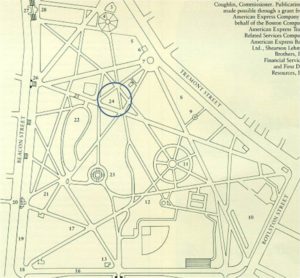 Boston Common
Boston Common
Tremont & Park Streets, Boston, MA
617.635.4505
cityofboston.gov
If you’re coming by car, just park in the Common Garage on Charles Street and take the elevator up. You’ll be on the Common. Or take the T’s Green Line, get off at the Arlington Street station and walk through the Public Garden, over the little bridge and across Charles Street. The Boston Common is always open and there is no admission fee.
You may have some difficulty finding the Great Elm plaque because it’s a ground level. Even when you’re looking for it, you may be, well, stumped. Here’s how to locate the plaque. Start at the entrance across from the Public Garden. Walk east, keeping the Civil War Memorial on your left. Do not go up the hill to the monument. When you have walked past the Frog Pond on the left, you will come to a triangular patch. Look toward the eastern point of the triangle and you’ll see the plaque at ground level.
It seems a small memorial to one of the city’s patriarchs and it’s easily overlooked. I have passed by it hundreds of times without knowing it was there. But, then, trees aren’t as charismatic as people — and they don’t vote.
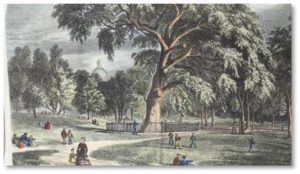
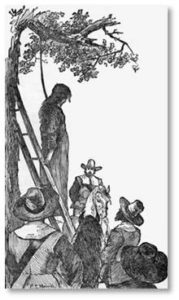
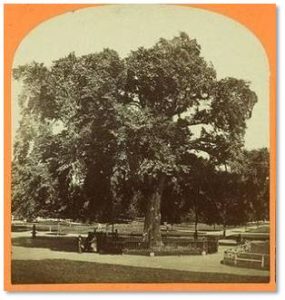
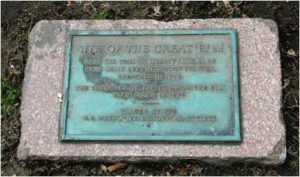

Perhaps you remember or even ate at the chinese restaurant on washington street where the dining room was located in the proscenium of a former theater. You had to go up a flight of stairs so when dining you were close to the proscenium ceiling. I believe it was knocked down and replaced by modern apartments. Wish Boston could repurpose instead if knocking down many of its old gems. I think of Boston as a pocket city – big but not too big. Small but not too small. It seems we are turning into a bigger shinier city.
Theresa: Unfortunately I do not remember that Chinese restaurant and it sounds like eating there was a memorable experience. Boston is a wonderful city for walking tours because it is not too big. I give architectural and historical walking tours for Boston By Foot and ghost tours for Haunted Boston. Come along sometime when we have Covid-19 under control. We have a great time.